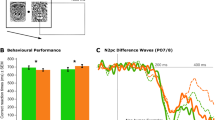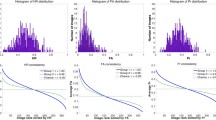Abstract
We sought to characterize electrophysiological, eye-tracking and behavioral correlates of face-name recognition memory in healthy younger adults using high-density electroencephalography (EEG), infrared eye-tracking (ET), and neuropsychological measures. Twenty-one participants first studied 40 face-name (FN) pairs; 20 were presented four times (4R) and 20 were shown once (1R). Recognition memory was assessed by asking participants to make old/new judgments for 80 FN pairs, of which half were previously studied items and half were novel FN pairs (N). Simultaneous EEG and ET recording were collected during recognition trials. Comparisons of event-related potentials (ERPs) for correctly identified FN pairs were compared across the three item types revealing classic ERP old/new effects including 1) relative positivity (1R > N) bi-frontally from 300 to 500 ms, reflecting enhanced familiarity, 2) relative positivity (4R > 1R and 4R > N) in parietal areas from 500 to 800 ms, reflecting enhanced recollection, and 3) late frontal effects (1R > N) from 1000 to 1800 ms in right frontal areas, reflecting post-retrieval monitoring. ET analysis also revealed significant differences in eye movements across conditions. Exploration of cross-modality relationships suggested associations between memory and executive function measures and the three ERP effects. Executive function measures were associated with several indicators of saccadic eye movements and fixations, which were also associated with all three ERP effects. This novel characterization of face-name recognition memory performance using simultaneous EEG and ET reproduced classic ERP and ET effects, supports the construct validity of the multimodal FN paradigm, and holds promise as an integrative tool to probe brain networks supporting memory and executive functioning.







Similar content being viewed by others
References
Ally, B. A., & Budson, A. E. (2007). The worth of pictures: using high density event-related potentials to understand the memorial power of pictures and the dynamics of recognition memory. NeuroImage, 35(1), 378–395. doi:10.1016/j.neuroimage.2006.11.023.
Ally, B. A., Waring, J. D., Beth, E. H., McKeever, J. D., Milberg, W. P., & Budson, A. E. (2008). Aging memory for pictures: using high-density event-related potentials to understand the effect of aging on the picture superiority effect. Neuropsychologia, 46(2), 679–689. doi:10.1016/j.neuropsychologia.2007.09.011.
Althoff, R. R., & Cohen, N. J. (1999). Eye-movement-based memory effect: a reprocessing effect in face perception. Journal of Experimental Psychology. Learning, Memory, and Cognition, 25(4), 997–1010.
Atri, A., O’Brien, J. L., Sreenivasan, A., Rastegar, S., Salisbury, S., DeLuca, A. N. Sperling, R. A. (2011). Test-retest reliability of memory task functional magnetic resonance imaging in Alzheimer disease clinical trials. Archives of Neurology, 68(5), 599–606. doi: 10.1001/archneurol.2011.94.
Benar, C. G., Schon, D., Grimault, S., Nazarian, B., Burle, B., Roth, M. Anton, J. L. (2007). Single-trial analysis of oddball event-related potentials in simultaneous EEG-fMRI. Human Brain Mapping, 28(7), 602–613. doi: 10.1002/hbm.20289.
Buckner, R. L. (2004). Memory and executive function in aging and AD: multiple factors that cause decline and reserve factors that compensate. Neuron, 44(1), 195–208.
Celone, K. A., Calhoun, V. D., Dickerson, B. C., Atri, A., Chua, E. F., Miller, S. L., & Sperling, R. A. (2006). Alterations in memory networks in mild cognitive impairment and Alzheimer’s disease: an independent component analysis. The Journal of Neuroscience, 26(40), 10222–10231.
Cohen, J. (1988). Statistical Power Analysis for the Behavioral Sciences (Second ed., ). Hillsdale, NJ:Lawrence Erlbaum.
Cronin-Golomb, A., Gilmore, G. C., Neargarder, S., Morrison, S. R., & Laudate, T. M. (2007). Enhanced stimulus strength improves visual cognition in aging and Alzheimer’s disease. Cortex, 43(7), 952–966.
Crutcher, M. D., Calhoun-Haney, R., Manzanares, C. M., Lah, J. J., Levey, A. I., & Zola, S. M. (2009). Eye tracking during a visual paired comparison task as a predictor of early dementia. American Journal of Alzheimer's Disease and Other Dementias, 24(3), 258–266. doi:10.1177/1533317509332093.
Curran, T. (1999). The electrophysiology of incidental and intentional retrieval: ERP old/new effects in lexical decision and recognition memory. Neuropsychologia, 37(7), 771–785.
Curran, T. (2000). Brain potentials of recollection and familiarity. Memory & Cognition, 28(6), 923–938.
Curran, T., & Cleary, A. M. (2003). Using ERPs to dissociate recollection from familiarity in picture recognition. Brain Research. Cognitive Brain Research, 15(2), 191–205.
Curran, T., & Hancock, J. (2007). The FN400 indexes familiarity-based recognition of faces. NeuroImage, 36(2), 464–471. doi:10.1016/j.neuroimage.2006.12.016.
Di Stasi, L.L., Renner, R., Staehr, P., Helmert, J.R., Velichkovsky, B.M., Cañas, J.J. Pannasch, S. (2010). Saccadic Peak Velocity Sensitivity to Variations in Mental Workload. Aviation, Space, and Environmental Medicine, 81(4), 413–417.
Di Stasi, L. L., Catena, A., Cañas, J. J., Macknik, S. L., & Martinez-Conde, S. (2013). Saccadic velocity as an arousal index in naturalistic tasks. Neuroscience & Biobehavioral Reviews, 37(5), 968–975.
Friedman, D. (2013). The cognitive aging of episodic memory: a view based on the event-related potential. Frontiers in Behavioral Neuroscience, 7(111), 1–15.
Goldmann, R. E., Sullivan, A. L., Droller, D. B., Rugg, M. D., Curran, T., Holcomb, P. J.,... Budson, A. E. (2003). Late frontal brain potentials distinguish true and false recognition. NeuroReport, 14(13), 1717–1720. doi: 10.1097/01.wnr.0000087908.78892.23.
Grober, E., Lipton, R. B., Hall, C., & Crystal, H. (2000). Memory impairment on free and cued selective reminding predicts dementia. Neurology, 54(4), 827–832.
Hampstead, B. M., Sathian, K., Moore, A. B., Nalisnick, C., & Stringer, A. Y. (2008). Explicit memory training leads to improved memory for face-name pairs in patients with mild cognitive impairment: results of a pilot investigation. Journal of the International Neuropsychological Society, 14(5), 883–889. doi:10.1017/s1355617708081009.
Hampstead, B. M., Stringer, A. Y., Stilla, R. F., Deshpande, G., Hu, X., Moore, A. B., & Sathian, K. (2011). Activation and effective connectivity changes following explicit-memory training for face-name pairs in patients with mild cognitive impairment: a pilot study. Neurorehabilitation and Neural Repair, 25(3), 210–222. doi:10.1177/1545968310382424.
Hayama, H. R., Johnson, J. D., & Rugg, M. D. (2008). The relationship between the right frontal old/new ERP effect and post-retrieval monitoring: Specific or non-specific? Neuropsychologia, 46(5), 1211–1223.
Herron, J. E., Quayle, A. H., & Rugg, M. D. (2003). Probability effects on event-related potential correlates of recognition memory. Brain Research. Cognitive Brain Research, 16(1), 66–73.
Heuer, H. W., Mirsky, J. B., Kong, E. L., Dickerson, B. C., Miller, B. L., Kramer, J. H., & Boxer, A. L. (2013). Antisaccade task reflects cortical involvement in mild cognitive impairment. Neurology, 81(14), 1235–1243. doi:10.1212/WNL.0b013e3182a6cbfe.
Li, J., Morcom, A. M., & Rugg, M. D. (2004). The effects of age on the neural correlates of successful episodic retrieval: an ERP study. Cognitive, Affective, & Behavioral Neuroscience, 4(3), 279–293.
McLaren, D. G., Sreenivasan, A., Diamond, E. L., Mitchell, M. B., Van Dijk, KR, Deluca, AN. Atri, A. (2012). Tracking cognitive change over 24 weeks with longitudinal functional magnetic resonance imaging in Alzheimer’s disease. Neuro-Degenerative Diseases, 9(4), 176–186. doi: 10.1159/000335876.
McLaren, D. G., Sperling, R., & Atri, A. (2014). Flexible modulation of network connectivity related to cognition in Alzheimer’s disease. NeuroImage, Epub ahead of print. doi: 10.1016.
Minear, M., & Park, D. C. (2004). A lifespan database of adult facial stimuli. Behavior Research Methods, Instruments, & Computers, 36(4), 630–633.
Mobascher, A., Warbrick, T., Brinkmeyer, J., Musso, F., Stoecker, T., Jon Shah, N., & Winterer, G. (2012). Nicotine effects on anterior cingulate cortex in schizophrenia and healthy smokers as revealed by EEG-informed fMRI. Psychiatry Research, 204(2–3), 168–177. doi: 10.1016/j.pscychresns.2012.09.005.
Nasreddine, Z. S., Phillips, N. A., Bédirian, V., Charbonneau, S., Whitehead, V., Collin, I., & Chertkow, H. (2005). The Montreal Cognitive Assessment, MoCA: A Brief Screening Tool For Mild Cognitive Impairment. Journal of the American Geriatrics Society, 53(4), 695–699.
Neargarder, S. A., & Cronin-Golomb, A. (2005). Characteristics of visual target influence detection of change in naturalistic scenes in Alzheimer disease. Cognitive and Behavioral Neurology, 18(3), 151–158.
Reitan, R. M., & Wolfson, D. (1985). The Halstead-Reitan neuropsychological test battery (2 ed., ). Tucson, AZ:Neuropsychology Press.
Rugg, M. D., & Curran, T. (2007). Event-related potentials and recognition memory. Trends in Cognitive Sciences, 11(6), 251–257. doi:10.1016/j.tics.2007.04.004.
Rugg, M. D., & Yonelinas, A. P. (2003). Human recognition memory: a cognitive neuroscience perspective. Trends in Cognitive Sciences, 7(7), 313–319.
Snodgrass, J. G., & Corwin, J. (1988). Pragmatics of measuring recognition memory: applications to dementia and amnesia. Journal of Experimental Psychology. General, 117(1), 34–50.
Sperling, R. A. (2007). Functional MRI studies of associative encoding in normal aging, mild cognitive impairment, and Alzheimer’s disease. Annals of the New York Academy of Sciences, 1097, 146–155.
Sperling, R. A., Bates, J. F., Cocchiarella, A. J., Schacter, D. L., Rosen, B. R., & Albert, M. S. (2001). Encoding novel face-name associations: a functional MRI study. Hum Brain Mapp, 14(3), 129–139. doi:10.1002/hbm.1047 [pii].
Sperling, R. A., Bates, J. F., Chua, E. F., Cocchiarella, A. J., Rentz, D. M., Rosen, B. R., & Albert, M. S. (2003). fMRI studies of associative encoding in young and elderly controls and mild Alzheimer’s disease. Journal of Neurology, Neurosurgery, and Psychiatry, 74(1), 44–50.
Vilberg, K. L., & Rugg, M. D. (2009). Functional significance of retrieval-related activity in lateral parietal cortex: Evidence from fMRI and ERPs. Human Brain Mapping, 30(5), 1490–1501. doi:10.1002/hbm.20618.
Walz, J. M., Goldman, R. I., Carapezza, M., Muraskin, J., Brown, T. R., & Sajda, P. (2013). Simultaneous EEG-fMRI reveals temporal evolution of coupling between supramodal cortical attention networks and the brainstem. The Journal of Neuroscience, 33(49), 19212–19222. doi:10.1523/jneurosci.2649-13.2013.
Wang, T. H., de Chastelaine, M., Minton, B., & Rugg, M. D. (2012). Effects of age on the neural correlates of familiarity as indexed by ERPs. Journal of Cognitive Neuroscience, 24(5), 1055–1068. doi:10.1162/jocn_a_00129.
Warbrick, T., Mobascher, A., Brinkmeyer, J., Musso, F., Stoecker, T., Shah, N. J., & Winterer, G. (2012). Nicotine effects on brain function during a visual oddball task: a comparison between conventional and EEG-informed fMRI analysis. Journal of Cognitive Neuroscience, 24(8), 1682–1694. doi:10.1162/jocn_a_00236.
Wechsler, D. A. (1997). Wechsler Adult Intelligence Scale-III (WAIS-III): The Psychological Corporation.
Yener, G. G., Guntekin, B., Oniz, A., & Basar, E. (2007). Increased frontal phase-locking of event-related theta oscillations in Alzheimer patients treated with cholinesterase inhibitors. International Journal of Psychophysiology, 64, 46–52.
Acknowledgments
This study and the writing of this paper were supported by grants, funds, facilities and resources at several institutions including by the Geriatric Research, Education, and Clinical Center (GRECC), ENRM Bedford Veterans Affairs Hospital, Bedford, MA, the GRECC Post Funds and the GRECC Investigators Funds; by the Atri Cure AD Fund at Massachusetts General Hospital, Boston, MA; by NIH grants to the Center for Functional Neuroimaging Technologies (P41RR14075), Dr. Atri (AG027171), and Dr. McLaren (AG042228); and by resources provided by the Ray Dolby Endowed Chair in Brain Health Research at the Ray Dolby Brain Center, California Pacific Medical Center, San Francisco, CA. Drs. Mitchell and Atri are former employees of the ENRM Bedford VA Hospital. Dr. Mitchell received support during this project through the VA Office of Academic Affairs (OAA) GRECC Advanced Fellowship in Geriatrics. The contents of this study do not represent the views of the Department of Veterans Affairs, the National Institutes of Health or the United States Government. We express our deep gratitude for the commitment of our study participants without whose generous contribution and dedication this research would not be possible. The authors have no conflicts of interest with the present study. All procedures performed in studies involving human participants were in accordance with the ethical standards of the institutional and/or national research committee and with the 1964 Helsinki declaration and its later amendments or comparable ethical standards.
Author information
Authors and Affiliations
Corresponding author
Additional information
Meghan B. Mitchell and Steven D. Shirk are co-primary authors.
Rights and permissions
About this article
Cite this article
Mitchell, M.B., Shirk, S.D., McLaren, D.G. et al. Recognition of faces and names: multimodal physiological correlates of memory and executive function. Brain Imaging and Behavior 10, 408–423 (2016). https://doi.org/10.1007/s11682-015-9420-6
Published:
Issue Date:
DOI: https://doi.org/10.1007/s11682-015-9420-6




